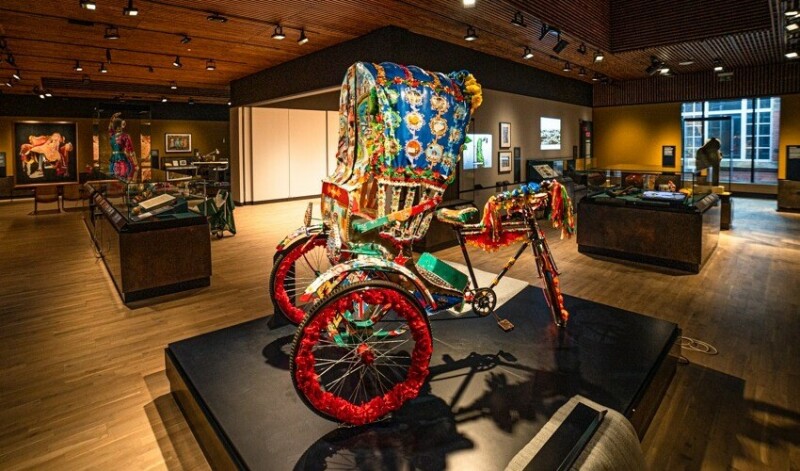Manchester Museum launches first ever South Asia Gallery
In 1911, Jacques Cartier, who started the jewelry empire as we know it today, visited Delhi for the coronation of King George V and Queen Mary as Emperor and Empress of India. There, Cartier was introduced to many wealthy Indians, including the Maharaja of Patiala, who wanted to modernise the royal jewellery collections. Today one of those pieces, an emerald brooch with diamonds and platinum from 1930 has gone on display in Manchester where a new South Asia Gallery has become the first permanent space in the UK dedicated to South Asians.
The Manchester Museum re-opened it’s doors to the public on February 18. The new multilingual gallery explores the connection between South Asia and Britain’s legacy of Empire. It has over 140 historic artefacts that take visitors on a journey from influential female figures of the Mughal Empire, like Nur Jahan; empress of Hindustan, through the impact of the British empire, including the trauma of the 1947 Partition.

The South Asian community in Greater Manchester is one of the largest in the UK, representing more than 20 percent of the population. It’s also one of the longest-established, with some families tracing their history in the region back five generations. Many are from India and Pakistan, countries directly impacted by British rule.
Some of the collective of co-curators have lent their own items or possessions that tell family stories.
They include Fal Sarker, grandson of quantum science pioneer Satyendra Nath Bose, whose items include letters between Bose and Einstein.
Nusrat Ahmed, South Asia Gallery Curator at Manchester Museum, said: “As a first-generation British-born South Asian person, it is really exciting to be part of such a groundbreaking project. The co-curated South Asia Gallery envisages a collaborative, iterative space that will generate new perspectives and connections. We hope to engage further diaspora communities on its opening and support its continual evolution. This personalized approach humanizes the gallery, telling stories about real people and their objects.”
Azraa Motala, a large-scale oil painting artist whose art feels familiar, and yet like nothing you’ve seen before. Her power piece at the South Asian gallery is about what it means to be British Asian today, titled ‘I beg you to define me, Constrain me in your warped ideology, Feel entitled to my identity, Project your prejudice on to me. I am more than you perceive, I will not submit to your ideals, I do not need your liberation, I am reconstructions anguish’

The anthology Past & Present looks at the impact of Gandhi’s visit to the cotton mill town of Darwen, Lancashire in 1931 - through the connection of Manchester’s cotton industry to the Indian independence movement. The public can explore the ancient Indus Valley Civilization through a contemporary lens, which shares perspectives beyond archaeologists’ perceptions of that time. It also presents powerful female figures of the Mughal Empire such as Nur Jahan, to reflect on the role of women.
Fresh voices and stories are central to the gallery. From stories around the social and cultural history of colonial India (e.g. from historian and professor Anindita Ghosh ) to the musical heritage of South Asia, (e.g. Balraj Singh Samrai, and his expertise on South Asian Music).
From celebrating the contribution of individuals to global fields such as science, (e.g. Collective member Fal Sarkar explores the story of his grandfather, Satyendra Nath Bose, one of the seminal founders of modern quantum science) ,to telling stories of inter-generational trauma through the impact of voluntary and involuntary migration (e.g a Collective member and journalist tells the story of her grandmother’s saree passed during partition).
A few new commissions have populated the space, celebrating contemporary South Asian creativity and innovation, including a rickshaw imported from Bangladesh and decorated by communities in Manchester and a 17-metre-long newly commissioned mural from British artists, The Singh Twins, illustrating an emotional map of South Asian diaspora experience.


Manchester Museum re-opened it’s doors following a £15 million transformation. The gallery is a key aspect of the Museum’s new social mission, to put diaspora communities of Manchester at the heart of its unique spaces and programmes alongside confronting the Museum’s imperial past and showcasing the city’s central role to the machine of the British Empire.
For the latest news, follow us on Twitter @Aaj_Urdu. We are also on Facebook, Instagram and YouTube.





















Comments are closed on this story.